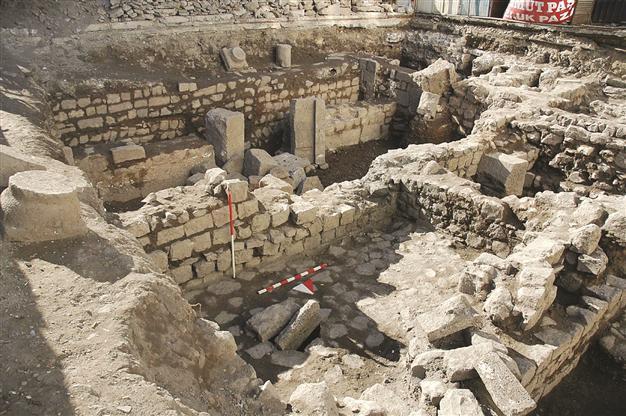Tomb and mosque on church remains
DİYARBAKIR - Dogan News Agency

A 1,600-year-old Roman church was discovered in the area of the tomb and mosque construction. DHA photo
1600-year old church area, which was revealed in the eastern province of Diyarbakır in 2007 and launched as a protected site by the Cultural and Natural Heritage Preservation Board, was first destroyed because of the lack of protection and the Directorate of Foundations began building a tomb on the historic remains, which date back to the Roman era.The construction, which is short of scientific and technical criteria, will end in the next month and the tomb and mosque will open to the public. Diyarbakır Foundations Director Metin Evsen said the documents showed the area was Sultan Sasa tomb and mosque, but their remains had not been found during excavations, and the construction was approved by the board decision.
The Diyarbakır Architects Chamber Chairman Necati Pirinçoğlu claimed the remains of a church, which were revealed during excavations, were deliberately damaged and now they were constructing a tomb and mosque on it.
Within the scope of the Diyarbakır Metropolitan Municipality’s project, an area on the Gazi Avenue was asked to be renovated by the Foundations Directorate. Then the Cultural and Natural Heritage Preservation Board asked the Museum Directorate to excavate the area. During the excavations, which started in November 2007 and lasted for 20 days, a 1600-year old Roman architecture structure was discovered. It was estimated that the historical structure was the additional building of Martoma Church, which was later on replaced by Ulu Mosque, and it was reported to the board, which approved it.
As some circles in the city claimed the area was the tomb of the first governor of Diyarbkır, Sahabe Sultan Sasa, the governor at the time, Avni Mutlu Dede, consulted with Dicle University. The university confirmed it was a church area and the area was launched as an archaeological site. The board asked the Foundations Directorate to make a project to open the area to tourism. The directorate did not take protection measures for a long time and the historical remains in the area were destroyed. Some artisans in the region used the historic church area as medium.
Upon pressure from some circles saying it was Sultan Sasa tomb, the Foundations Directorate applied once again to the Cultural and Natural Heritage Preservation Board and asked it to remove its decision to be an archaeological site. The board approved the construction of a mosque and tomb with the condition of the conversion of church remains.
The construction of the mosque started in January 2013 and it was seen that the archaeological remains were not conserved and they were covered with iron colons.
Diyarbakır Architects Chamber Chairman Pirinçioğlu claimed some circles and the Foundations Directorate did not take measures and overlooked the devastation of the remains. “The Sultan Sasa tomb was moved from this region in 1925. We are not against the construction of a mosque, but who needs another mosque right next to the Ulu Mosque, which is considered as the 5th temple mount of the world? Some circles have been carrying out campaigns to change the identity of this multi-cultural city. We need to protect our historical structures,” he said.
Claims not true
On the other hand, the Diyarbakır Governor’s Office defended that the construction of a mosque on church remains were not true. In a written statement, the governor’s office said the area belonged to the Mazbut Sultan Sasa Foundation and was launched as a first degree registered structure by the Preservation Board on Dec. 14, 2007.
“Following the discovery of remains, the board asked for the preparation of a conversion project. Documents do not mention the existence of a church here and this is why the claims that a mosque was constructed on its remains are not true,” the statement said.
















